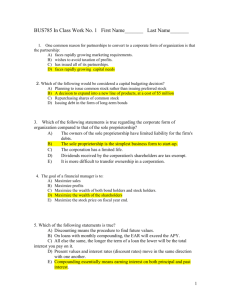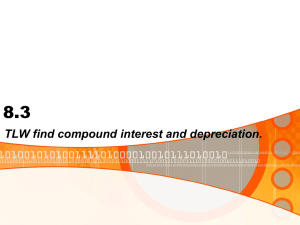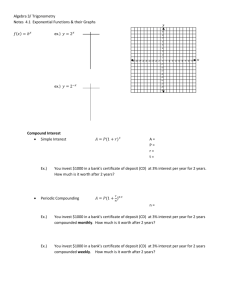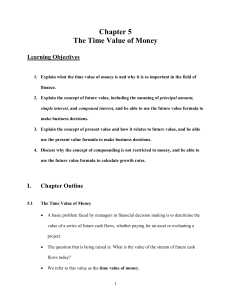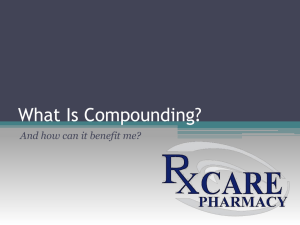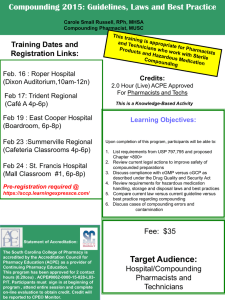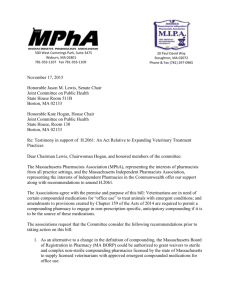Chapter 21
advertisement
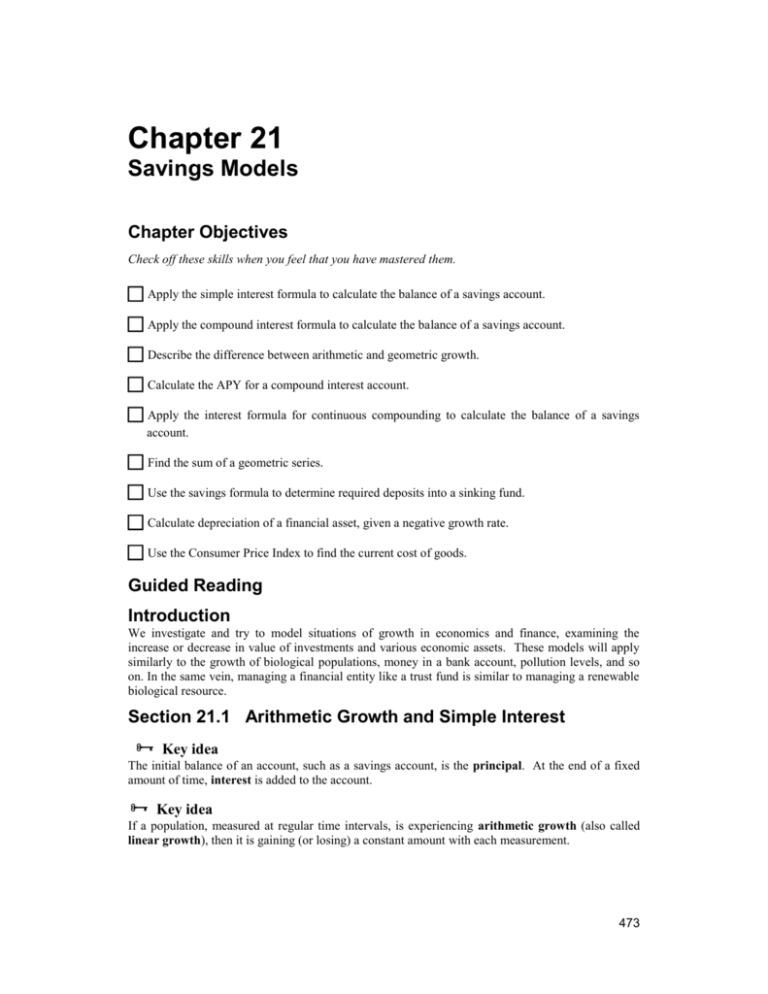
Chapter 21 Savings Models Chapter Objectives Check off these skills when you feel that you have mastered them. Apply the simple interest formula to calculate the balance of a savings account. Apply the compound interest formula to calculate the balance of a savings account. Describe the difference between arithmetic and geometric growth. Calculate the APY for a compound interest account. Apply the interest formula for continuous compounding to calculate the balance of a savings account. Find the sum of a geometric series. Use the savings formula to determine required deposits into a sinking fund. Calculate depreciation of a financial asset, given a negative growth rate. Use the Consumer Price Index to find the current cost of goods. Guided Reading Introduction We investigate and try to model situations of growth in economics and finance, examining the increase or decrease in value of investments and various economic assets. These models will apply similarly to the growth of biological populations, money in a bank account, pollution levels, and so on. In the same vein, managing a financial entity like a trust fund is similar to managing a renewable biological resource. Section 21.1 Arithmetic Growth and Simple Interest Key idea The initial balance of an account, such as a savings account, is the principal. At the end of a fixed amount of time, interest is added to the account. Key idea If a population, measured at regular time intervals, is experiencing arithmetic growth (also called linear growth), then it is gaining (or losing) a constant amount with each measurement. 473 474 Chapter 21 Example A If an account has an initial value of $500 and gains $150 at each interval, write the sequence of population values for the first ten intervals. Solution Starting with the initial value $500, successively add $150. The result is: $500, 650, 800, 950, 1100, 1250, 1400, 1550, 1700, 1850. Key idea A financial account which is paying simple interest will grow arithmetically in value. If we let I be the interest earned, P be the principal, r be the annual rate of interest, A be the total amount (including principal and interest), and t be the number of years, the formulas involving simple interest are as follows. I Prt and A P I P Prt P 1 rt Question 1 If $5000 is invested at an annual rate of 2.4% with simple interest, how much money is in the account after 4 years? Answer $5480 Section 21.2 Geometric Growth and Compound Interest Key idea A savings account which earns compound interest is growing geometrically. At the end of the first year, the initial balance, or principal, is increased by the interest payment. Each successive year, the new balance is the previous balance plus interest, paid as a fixed percentage of that balance. The value of the savings account is determined by the principal (or initial balance), the rate of interest, and the compounding period. Example B Suppose you deposit a $2000 principal to start up a bank account with an annual interest rate of 8%, compounded quarterly. How much money will you have in the account at the end of the first year? Solution Each quarter the value of the account grows by 1/4 of the annual interest of 8%. This means the account balance is multiplied by 1.02 four times in the course of the year. Here is a table of account values. initial deposit quarter 1 quarter 2 quarter 3 quarter 4 $2000 $2040 $2080.80 $2122.42 $2164.86 There will be $2164.86 at the end of the year. Key idea The annual interest rate of a savings account is called the nominal rate. With compounding, the actual realized percentage is higher; it is called the effective annual rate, or EAR. Key idea The nominal rate i for a period during which no compounding is done is given by i the nominal annual rate and n is the number of times interest is compounded per year. r , where r is n Savings Models 475 Example C For an account earning 9% interest compounded monthly, what is the nominal rate i for a one-month period? Solution Because r = 9% and n = 12, i 0.09 12 0.0075 or 0.75% per month. Key idea The compound interest formula for the value of a savings account after compounding periods is as follows. A P 1 i n Here, P is the principal and i is the interest rate per compounding period. Example D If $1000 is deposited in an account earning 12% interest compounded annually, what will be the value of the account: a) after 5 years? b) after 20 years? Solution a) With annual compounding, we have one interest payment each year, or five in five years. Because i = 12% = 0.12, the formula for the value of the account after 5 years is A 1000 1 0.12 $1762.34. 5 b) After 20 years we have A 1000 1 0.12 $9646.29. 20 Question 2 If $5000 is deposited in an account earning 2.4% interest compounded quarterly, what will be the value of the account: a) after 5 years? b) after 20 years? Answer a) $5635.46 b) $8068.79 Example E If $1000 is deposited in a different account earning 12% interest compounded monthly, what will be the value of the account: a) after 5 years? b) after 20 years? Solution a) With monthly compounding, we have 12 interest payments per year, or 60 in five years. Now $1816.70. the formula for the value of the account after 5 years is A 1000 1 0.12 12 60 b) After 20 years, we have 240 interest periods, so A 1000 1 0.12 12 240 $10,892.55. 476 Chapter 21 Key idea The present value P of an amount A to be paid in the future, after earning compound interest or n compounding periods at a rate i per compound period is as follows. A P n 1 i Key idea If a population is experiencing geometric (exponential) growth, then it is increasing or decreasing by a fixed proportion of its current value with each measurement. The proportion is called the growth rate of the population. Key idea Accounts earning compound interest will grow more rapidly than accounts earning simple interest. In general, geometric growth (such as compound interest) is much more dramatic than arithmetic growth (such as simple interest). Section 21.3 A Limit to Compounding Key idea For a nominal interest rate r compounded n times per year, the annual effective interest rate, or APY, is 1 r n n 1. Example F What is the APY for 7.5% compounded monthly? Solution Because r = 0.075 and n = 12, the APY is 1 nr 1 1 0.075 12 1 1.00625 1 0.0776 or n 12 12 7.76%. Key idea Compounding interest more often results in a higher value in the account because interest is earned earlier and is included with the principal in the next compounding period. However, the more often interest is compounded, the less significant this increase becomes. The limit is reached when interest is compounded continuously. The formula for finding the account balance when interest is compounded continuously is A Pert , where r is the nominal interest rate and t is the time in years. e is a constant which is approximately equal to 2.718281828. The pattern of decimals do not repeat and does not yield a rational number. Example G If $1000 is deposited into an account earning 9% interest compounded continuously, find the value of the account after a) 5 years. b) 10 years. Solution a) Using a calculator we find that A 1000e 0.09 5 1000e0.45 $1568.31. b) Similar to what was done in part a), we have A 1000e 0.09 10 1000e0.90 $2459.60. Savings Models 477 Key idea There is virtually no difference whether a bank treats a year as 365 days or 360 days. The 365 over r 365 method with a daily nominal rate of 365 is the usual method for daily compounding. The 360 over 360 method with a daily nominal rate of installments. r 360 is the usual method for loans with equal monthly Note: In the Student Solutions Guide, the solution to Exercise 13 should use the formulas r P 1 360 360 r and P 1 365 365 in parts b and c, respectively. Question 3 If $10,000 is deposited into an account with annual rate of 2.7%, what is the amount in the account after 1 year if it is compounded a) continuously? b) using the 365 over 365 method? c) using the 360 over 360 method? Answer a) $10,273.68 b) $10,273.67 c) $10,273.67 Section 21.4 A Model for Investment Key idea A geometric series with first term 1, common ratio x, and n terms is the following. 1 x x2 ... xn1 n x 1 . The sum of these terms is x 1 Key idea We can accumulate a desired amount of money in a savings account by a fixed date by making regular deposits at regular intervals a sinking fund. With a uniform deposit of d dollars at the end of each interval, and an interest rate of i per interval, the savings formula predicts that the value of the account after n intervals will be as follows. 1 i n 1 Ad i This formula is obtained by summing a geometric series of accumulated deposits and interest. 478 Chapter 21 Example H Rosetta’s flower shop is growing, and she will need $6000 five years from now to pay for an addition to her greenhouse. How much would she have to deposit each month in a sinking fund with a 6% annual interest rate to accumulate this amount? Solution Here, d is the unknown amount to be deposited, i 0.06 12 0.005 is the monthly interest rate and n 5 12 60, the number of deposits in 5 years. Then we can solve for d in the savings formula as follows. 1 i n 1 Ad i 1 0.005 60 1 6000 d 0.005 6000 d 69.770030510 d 6000 $86.00 69.770030510 Rosetta would deposit $86 at the end of each month for 5 years. Key idea An annuity pays a specified number of equal payments at equally spaced time intervals. A sinking fund is the reverse of an annuity. With a sinking fund you make payments and with an annuity you receive payments. Section 21.5 Exponential Decay and the Consumer Price Index Key idea Geometric growth with a negative growth rate is called exponential decay. Examples are depreciation of the value of a car and decay in the level of radioactivity of a given quantity of a radioactive isotope. The quantity is declining at a rate which is negative and proportional to its size; the proportion l is called the decay constant. Example I If a car costs $12,000 new and its value depreciates at 20% per year, give a formula for its value after n years and predict its value in five years. Solution The general formula is A P 1 i , where P = $12,000, i 0.2, n 5. n The formula is A = 12,000 0.8 and the value A = $3932.16 can be found using a calculator. n Key idea With inflation, the value of currency declines. If the rate of inflation is a, then the present value of a $1 $a dollar in one year is given by the formula $1 . 1 a 1 a Savings Models 479 Example J Assuming constant 7% inflation, what would the present value of a $50 bill be in five years? Solution $1 0.93458. or 93.46 cents. After 1 0.07 five years, the present value has shrunk by this factor five times. Thus, after five years one dollar has 5 $1 a value of 0.7130, or 71.3 cents. Multiplying this by 50 we have $35.65. 1 0.07 The present value of one dollar after one year is given by Key idea The Consumer Price Index (CPI) is the measure of inflation. The CPI compares the current cost of certain goods, including food, housing, and transportation, with the cost of the same (or comparable) goods in a base period. Key idea To convert the cost of an item in dollars for one year to dollars in a different year, use the following proportion. Cost in year A CPI for year A Cost in year B CPI for year B You will need to use Table 21.5 on page 816 of your text to obtain the CPI for a particular year. Example K Rodney bought a house in 1967 for $25,000 and sold it in 2004. How much would the house be worth in 2004 dollars? Solution Set up the following proportion using values from Table 21.5. Cost in 1967 CPI for year 1967 Cost in 2004 CPI for year 2004 $25,000 33.4 Cost in year 2004 189.5 $25,000 189.5 33.4 Cost in year 2004 Cost in year 2004= $4,737,500 $141,841.3174 33.4 The house is worth around $142,000. Section 21.6 Real Growth and Valuing Investments Key idea An investment is affected by the rate of inflation. An investment that grows at, say, 6.5% per year will not actually gain purchasing power at 6.5% per year if inflation is considered. Key idea If an investment grows at an annual rate r and the rate of inflation is a, the real growth rate g is given by the following. r a g 1 a 480 Chapter 21 Example L In late 2001 the inflation rate was about 2.9%. If you invested in a savings account with an annual interest rate of 6.5%, what was the real growth rate of this investment? Solution In this case, r 6.5% 0.065 and a = 2.9% = 0.029, so we have the following. g r a 0.065 0.029 0.036 0.03499 1 a 1 0.029 1.029 Key idea Buyers of stock in a company receive part of the profits of the company in the form of cash payments, known as dividends. Key idea An overvalued stock is one that has a current price that is too high compared to the company’s expected earnings. Key idea Modeling the value of a stock requires considering the growth rate of the annual dividend as well as the discount rate. The discount rate for a stock takes into account the effects of inflation, the level of risk for that particular stock, and the value of interest on alternate investments. Key idea Suppose you want to buy a stock at the beginning of the year and D was last year’s dividends, paid at the beginning of this year to those that owned stock on a particular date, g is the annual rate the company expands and prospers and r is the discount rate per year, then the present value of next 1 g year’s dividends is D . 1 r Key idea An option to buy a stock at a certain price by a certain time is an example of a “financial derivative.” The true value of a derivative depends on the current value and the probabilities that the stock will go up or down within the option’s time frame. The famous “Black-Scholes formula” is often used to value financial derivatives. Homework Help Exercises 1 – 10 Carefully read Sections 21.1 and 21.2 before responding to these exercises. Exercises 11 – 16 Carefully read Section 21.3 before responding to these exercises. Exercises 17 – 28 Carefully read Section 21.4 before responding to these exercises. Exercises 29 – 42 Carefully read Section 21.5 before responding to these exercises. Exercises 43 – 50 Carefully read Section 21.6 before responding to these exercises. Savings Models 481 Do You Know the Terms? Cut out the following 23 flashcards to test yourself on Review Vocabulary. You can also find these flashcards at http://www.whfreeman.com/fapp7e. Chapter 21 Savings Models Chapter 21 Savings Models Annual percentage yield (APY) Chapter 21 Savings Models Arithmetic growth Chapter 21 Savings Models Compound interest formula Chapter 21 Savings Models Constant dollars Annuity Chapter 21 Savings Models Compound interest Chapter 21 Savings Models Compounding period Chapter 21 Savings Models Continuous compounding 482 Chapter 21 A specified number of payments at equal intervals of time. The effective interest rate per year. Interest that is paid on both the original principal and accumulated interest. Growth by a constant amount in each time period. The fundamental interval compounding, within which compounding is done. for no Formula for the amount in an account that pays compound interest periodically. For an initial principal P and effective rate i per compounding period, the amount after n n compounding periods is A = P 1 + i . Payment of interest in an amount toward which compound interest tends with more and more frequent compounding. Costs are expressed in constant dollars if inflation or deflation has been taken into account by converting the costs to their equivalent in dollars of a particular year. Savings Models Chapter 21 Savings Models Chapter 21 Savings Models Current dollars Chapter 21 Savings Models Effective annual rate (EAR) Chapter 21 Savings Models Exponential decay Chapter 21 Savings Models Geometric growth e Chapter 21 Savings Models Effective rate Chapter 21 Savings Models Exponential growth Chapter 21 Savings Models Geometric series 483 484 Chapter 21 The base for continuous compounding, geometric (exponential) growth, and natural logarithms. The actual cost of an item at a point in time; inflation or deflation before or since then has not been taken into account. The actual percentage rate, taking into account compounding. It equals the rate of simple interest that would realize exactly as much interest over the same period of time. The effective rate per year. Geometric growth. A sum of terms, each of which is the same constant times the previous term; that is, the terms grow geometrically. Geometric growth at a negative rate. Growth proportional to the amount present. Savings Models Chapter 21 Savings Models Chapter 21 Savings Models Interest Chapter 20 Tilings Linear growth Chapter 21 Savings Models Nominal rate Chapter 21 Savings Models Present value Chapter 21 Savings Models Principal Chapter 21 Savings Models Sinking fund Simple interest 485 486 Chapter 21 Arithmetic growth. Money earned on a savings account or a loan. The value today of an amount to be paid or received at a specific time in the future, as determined from a given interest rate and compounding period. A stated rate of interest for a specified length of time; a nominal rate does not take into account any compounding. The method of paying interest only on the initial balance in an account, not on any accrued interest. Initial balance. A savings plan to accumulate a fixed sum by a particular date. Savings Models 487 Practice Quiz 1. If you deposit $1000 at 5.2% simple interest, what is the balance after three years? a. $1140.61 b. $1164.25 c. $1156.00 2. Suppose you invest $250 in an account that pays 2.4% compounded quarterly. After 30 months, how much is in your account? a. $265.41 b. $299.14 c. $268.00 3. A home was purchased in 1976 for $25,000. How much would a comparable house be worth in 1999? (Assume the 1976 CPI is 56.9 and the 1999 CPI is 166.2.) a. about $25,290 b. about $73,023 c. about $85,589 4. What is the APY for 4.8% compounded monthly? a. 4.8% b. 4.9% c. 5.2% 5. If a bond matures in 3 years and will pay $5000 at that time, what is the fair value of it today, assuming the bond has an interest rate of 4.5% compounded annually? a. $4381.48 b. $4325.00 c. $4578.65 6. The stated rate of interest for a specific length of time is called the: a. APY b. effective rate c. nominal rate 7. Suppose your stock portfolio increased in value from $12,564 to $12,870 during a one-month period. What is the APY for your gains during this period? a. 29.2% b. 32.6% c. 33.5% 8. Suppose you buy a new tractor for $70,000. It depreciates steadily at 8% per year. When will it be worth approximately $10,000? a. after about 11 years b. after about 18 years c. after about 25 years 488 9. Chapter 21 Suppose a stock worth $50 today is equally likely to be worth $100 or $25 a year from today. What is a fair price to pay today for the option to buy this stock a year from now? a. about $7.50 b. about $10 c. about $12.50 10. Suppose a stock worth $50 today is equally likely to be worth $75 or $35 a year from today. What is the expected value of this stock a year from now? a. $75 b. $55 c. $50 Savings Models 489 Word Search Refer to pages 822 – 823 of your text to obtain the Review Vocabulary. There are 22 hidden vocabulary words/expressions in the word search below. It should be noted that no abbreviations appear and spaces are removed. Interest, Compound Interest, and Compound Interest Formula, appear separately. Also, the symbol e is not considered part of the search. 1. __________________________ 12. __________________________ 2. __________________________ 13. __________________________ 3. __________________________ 14. __________________________ 4. __________________________ 15. __________________________ 5. __________________________ 16. __________________________ 6. __________________________ 17. __________________________ 7. __________________________ 18. __________________________ 8. __________________________ 19. __________________________ 9. __________________________ 20. __________________________ 10. __________________________ 21. __________________________ 11. __________________________ 22. __________________________
